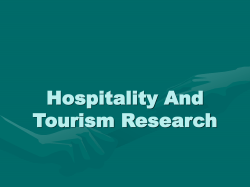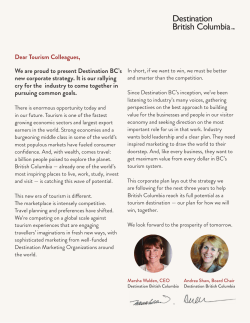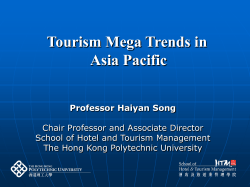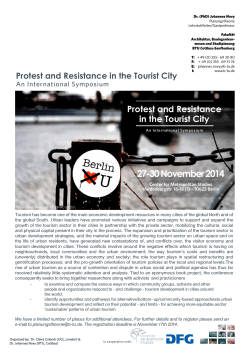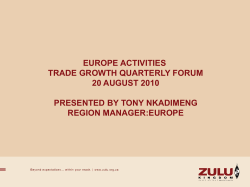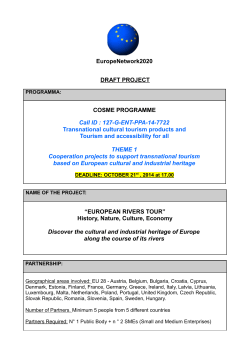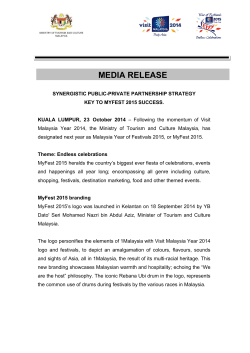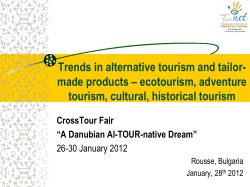
PERCEPTIONS OF SUSTAINABLE TOURISM BY TOURISTS
International Journal of Economics, Commerce and Management United Kingdom Vol. II, Issue 11, Nov 2014 http://ijecm.co.uk/ ISSN 2348 0386 PERCEPTIONS OF SUSTAINABLE TOURISM BY TOURISTS AND THEIR IMPACT ON THE ENVIRONMENT CASE STUDY OF RUGOVA REGION, KOSOVO Dauti, Merita Begolli University “HAXHI ZEKA”, Pejë, Kosovo merita_dauti@hotmail.com Abstract Tourism development in Rugova region is possible because it owns a big number of touristic sources. This project is based on questionnaires in which tourists who have visited this region were surveyed. The aim of this paper if to provide empiric proves about how many is the number of tourists that visit Rugova region and how their attitudes and perceptions are regarding sustainability of natural beauties, hospitality and many other characteristics which influence in environment protection. Data was collected from tourists, non-residents using questionnaires with closed questions and with likert scale. Analyses show that perception and concept of sustainable tourism considerably is known by tourists’ nonresidents while a small number did not have knowledge about this concept. So from this project we can see that the aim of sustainable development is fulfilling the needs of actual tourist in Rugova region while on the other hand they are aware that culture identity, essential ecologic processes, and ecologic diversity should be protected by host places. Key words: Tourism, economy, tourist, sustainability, Kosovo INTRODUCTION Concept of stabile development even that was not targeting in specific manner development of tourism, with no doubt had a reasonable influence in tourism sector. The stabile development has for intention to secure and offer a stable and secure life, which minimizes the use and depletion of natural sources, degradation of the environment, cultural divisions and social instability (Hall, 1998). The notion of sustainable tourism development on the other hand has emerged as a possible solution against environmental and social degradation of natural Licensed under Creative Common Page 1 © Dauti resources by the development of industry and due to the fact that tourism is an industry which is entirely dependent on the beauties and natural resources and cultural heritage of society. Although there is considerable polarization in viewpoints and definitions of sustainable tourism is recognized that achieving sustainability in the tourism context requires: a strategic orientation towards tourism planning and increase the participation of multiple stakeholders in the planning process tourism. The importance of tourist industry in world economy cause of the potential and dimensions that possesses was considered to be essential; regardless of this tourism was not addressed in specific way in LA21. However, importance of tourism in global economy as well as importance of using the natural resources was emphasized clearly by World Tourism Organization (WTO) presented working plan of development as “Stabile Tourism Agenda 21” for tourism and touristic industry. On 1999, WTO furthermore developed the Code of Ethics in global aspect for responsible and stabile development of international tourism that included nine articles defining essential regulations for governments, touristic operators, developers, travel agents, workers as well as communities and tourists itself. In this context was noticed that tourism could contribute in effective way in stabile development when, "... It operates within the natural capacity for regeneration and future productivity of natural resources; recognizes the contribution that people and communities, customs and lifestyles, make to the tourism experience; acknowledges that these people should have an equal share in economic life, tourism benefits, and is guided by the wishes of local population and communities in the host areas" (www.wto.org). Economic and Environmental Perceptions of Stabile Tourism Economy and environmental protection are often elements that stay in center of the concept of sustainability and are most usual fields of the focus of stabile tourism that are located within analysis and studies of sustainable tourism. Authors McIntyre, Hetherington and Inskeep; regarding the protection of environment within the achieving of successful tourism development emphasize that tourism should be stable for the environment to be economically acceptable. In fact authors go further than that saying that tourism and environment are interrelated between each other and conflicts arise when the development of tourism is needed to fulfill increased requests of touristic activities without decreasing attraction abilities of the destination. Nijkamp and Verdonkschot accept that problems occur when trying to fulfill needs of hosting community and improving the standards of life, as well as protecting the environment of the touristic destination and cultural heritage( Nijkamp, P., & Verdonkschot, S. 1995). Two other authors as Vesenjak (1996) and Bouguessa (1996) dealing with the question that how will be the future of tourism, have inserted an economic focus and came to the conclusion that tourism could Licensed under Creative Common Page 2 International Journal of Economics, Commerce and Management, United Kingdom continue to be stabile only if it’s economically successful. In particular Bouguessa (1996) believes that stabile tourism could contribute not only in welfare of the population and tourists but also in recovery of local economies. In other words communities can find in stabile tourism economic incentive and improvement of life standard (Bouguessa, H. 1996). Natural potentials do not itself constitute touristic potential if would be a lack of interested and needed public for them it means the visitors from different countries (Doka Dhimiter & Draçi Bilal, 2009). Participation in touristic travels even though on the first view seem as simple, practices showed that are very complicated. In its own includes big number of activities. In touristic travels are visited places which for tourists are new or are visited earlier. In this context one touristic destination is being defined as a physical space in which one visitor spends at least one night and consumes touristic products as well as supporting services and touristic attractions of that destination (UNWTO, 2006). During the visit you meet different people and different cultures. Except the preparation of tourists for travel should be prepared also local people for tourist hospitality by the representatives of touristic agencies, merchants, political parties and general local population (Gradijan. p.40). Rugova Region Rugova region by its natural potential with many beauties and its riches with waters as natural sources, lakes in different heights, many caves, scenic landscapes of mountain ranges connected to each other with high tops, with rich flora and fauna lying in whole region offers huge possibilities for holidays and for recreation. Rugova is mountain area in North-West of Peja city in Kosovo. It is the 3rd region of the Cursed Mountains known also as Albanian Alps. It includes a territory within a space of 20330 ha. It has a scope in East-West in length from 23 km. It is located between mountains of Hajla, Shtedim, Lumbardh and Kopranik. River of Lumbardhe divides it in two parts creating a valley and furthermore during the flow the deep canyon (Pushka, Asllan & Krasniqi, Nevzad 2012). On 2013, it was declared as National Park by the Assembly of Kosova Republic. In Rugova region are located 13 villages (Shtupeqii Vogël, Shtupeqii Madh, Reka e Allagës, Drelaj, Pepiq, Malaj, Kuqishtë, Dugaivë, Haxhaj, Stankaj, Bogë, Shkreldhe Koshutan) and five small streets (Llaz, Bollpaç, Pecaj, Ujëmirë, Dreshaj). Villages are in distance from each other 2-7km, inhabited by “Rugovanians” who are known for their affection towards the environment with their specific cultural activities and the practices of folklore. The highest point of the Rugova valley reaches until 2560m above sea level and the area is very rich with rivers, natural lakes located on 1800m above the forests, 30m high waterfalls and few natural caves. (http://www.balkansgeotourism.travel). Licensed under Creative Common Page 3 © Dauti Figure 1: Lake of Leqinat Photograph by Nëntori; Source: www.commons.wikimedia.org/wiki/file:leqinat_lake.jpg Rugova is adequate region for climbing, mountaineering, skiing, rock climbing, parachute jumping, family picnics etc. forest climate of Rugova region with hot summers and long and cold winter, favors without reserve tourists to breathe there a fresh air, with ions coming from the forest in the early morning until nine o’clock that are stimulators for the human health (http://kk.rks-gov.net/Peje/Municipality). Rugova has big and attracting resources for tourist development. Last years the tourism started to burst. Forest climate, natural beauties, varied flora and fauna as well as investments in infrastructure and building of shops, hotels, restaurants, motels and private house for serving and sheltering of tourists are main factors that make tourism possible. Figure 2: Bridge in Rugova Gorge Photograph by Besnik Matoshi; Source: www.flickr.com/photos/besnikmatoshi Licensed under Creative Common Page 4 International Journal of Economics, Commerce and Management, United Kingdom METHODOLOGY Methods which are used for project are based in available scientific literature, legal documents from tourism sector and respective sectors as well as surveys through questionnaires focused on foreign tourists in a sample of 100 questionnaires in which 96 from them were ready to answer. Based to the questionnaires we will see their perceptions regarding development of stabile tourism as well as the impact of tourism in environment in Rugova region. Mainly countries from where tourists came from were: Macedonia, Albania, Montenegro but there were also tourists from other countries as Germany, Switzerland, Italy. Questionnaires were spread on the area during months of June, July, August and September. So this identifies peak of touristic season, where tourists use these months to visit natural beauties in Rugova region. Methods of work present combination of a) abstract- theoretical part based on the study of scientific literature b) analyzing of existing strategically documents c) empirical part through analyzing of surveys. Table 1: Question and answer from Surveys S/N Questions 1. Gender 2. Which of the following age groups you are in? 3. Which is the status of your education? 4. Which is the status of your employment? 5. The way how you arrived in Kosova? 6. Where did you get informed for our country? 7. Is this your first visit to our country? Licensed under Creative Common Indicators Male Female 16-24 25-34 35-44 45-54 55-64 65+ Elementary High School University Post University Employed Unemployed Retired Student/pupil By vehicle By Bus By airplane Media Touristic guides Travel Agencies Friends and relatives Yes No Frequency 63 33 18 24 22 14 11 7 0 8 64 24 43 12 7 34 44 36 16 9 25 37 25 28 68 % 65.625 34.375 18.75 25 22.916 14.583 11.4583 7.2916 0 8.3 66.7 25 44.7916 12.5 7.2916 35.416 45.83 37.5 16.6 9.375 26.0416 38.5416 26.0416 29.16 70.83 Page 5 © Dauti 8. How long did you decided to stay in our country? 9. Which are the reasons that you are visiting our country? 10. Where are u located-spending the night? 11. Are the citizens of this place friendly towards the visitors? 12. Does Rugova landscapes? region have unique 13. Do the visitors in our country protect the environment? 14. Are the prices for food and sleeping reasonable? 15. Is the concept “Sustainable Tourism” known for you? 16. Do you believe that protecting the natural resources and tourism are in compliance? 17. Do you believe that community will have benefit from development of sustainable tourism? 18. Do you as a tourist visiting our country think to protect natural resources? 19. Are you as a tourist aware about sustainable matters in place and to influence in their activities? Licensed under Creative Common 2-4 5-8 9-14 15-20 Holidays and Relaxing Visiting family members and friends. Business matters Culture Hotel Apartments Hostel Eco house Family and friends Yes No Strongly disagree Fairly agree Until certain point agree Agree Completely agree Strongly disagree Fairly agree Until certain point agree Agree Completely agree Yes No Till certain point Very known Not known Strongly disagree Fairly agree Until certain point agree Agree Completely agree Strongly disagree Fairly agree Until certain point agree Agree Completely agree 53 31 12 0 59 55.2083 32.2916 12.5 0 61.4583 18 18.75 6 13 32 8 17 21 18 96 0 0 0 9 28 59 0 8 15 44 29 42 17 37 65 31 18 33 21 16 8 8 4 19 21 44 6.25 13.5416 33.3 8.3 17.7083 21.875 18.75 100 0 0 0 9.375 29.16 61.4583 0 8.3 15.625 45.83 30.2083 43.75 17.7083 38.5416 67.7083 32.2916 18.75 34.375 21.875 16.6 8.3 8.3 4.16 19.7916 21.875 45.83 Yes 96 100 No 0 0 Yes 65 67.7083 No 31 32.2916 Page 6 International Journal of Economics, Commerce and Management, United Kingdom 20. Sustainable tourism is defined as “Fullfilling of present tourist needs and hostess regions, protecting and increasing possibilities for the future”. I am interested to know is this concept achievable? Yes 61 63.5416 No 6 6.25 Until certain point 29 30.2083 FINDINGS From collected information a presentation with some texture of foreign tourists in this study. The number of surveyed persons was total 96 where 63 of them were male gender while 33 were female gender. The tourists were from different ages, most of them were from middle age 2554. Most of them had university level of education and as for employment a big number of them were employed. The way how they managed to come to Kosova were by different transporting means; vehicle 44, by bus 36, by airplane 16. Information about our country they provided from media, touristic guides, travel agencies and from friends and family. As for their visit here this was not their first visit in our country, these tourists frequented the place many times before. Most of them planned to stay 4-8 days mostly. The reason of visits by the visitors was different but most of them came for holidays and relax. As for accommodation all tourists used different manners for overnight. As for perception of tourists regarding our country their answer was that they were 100% content with people and their hospitality, most of them answered that Rugova region has unique landscapes, as for protection of the environment by visitors they gave different answers. Were reasonable prices for a night and food most of them agreed or until certain point agreed with the prices of touristic offer of the Region? The answers of the question how much knowledge do you have regarding the concept “Sustainable tourism”, big number of tourists 65 of them knew the concept, the reason was because only them had university qualification while the others didn’t know about the concept. As for the question do you believe that could be in compliance protection of natural resources and tourism, there were different opinions regarding the answers of tourists? The opinion of tourists was positive where community would have benefit from sustainable tourism and tourist answers regarding the protection of the nature of our country were 100% positive. About the last question which was the most important question was: Sustainable tourism was defined as “Fulfilling of present tourist needs and hostess regions, protecting and increasing possibility for the future”, is this concept achievable where most of the tourists 61 answered YES, 6 NO and, 29 tourists Until Certain Point. So with this study we came to the conclusion that a big number of tourists are aware for consequences in environment, and in every manner should try to minimize the use and drain the natural resources and degrading the environment. Licensed under Creative Common Page 7 © Dauti CONCLUSIONS Touristic value have in almost all regions in Kosova in any forms and dimensions depending from resources and their growth rate, but Rugova region with its natural potential, with many beauties and its richness increases the value of the touristic offer of our country. A well thought sustainable development of these resources can empower life in community in its entire region. In last times is expected for tourism to have rapid growth. This growth will be used not only for tourist satisfaction but also for increase of life standard of communities and hostess places. At the same time this will bring also negative social economic impacts for which involvement in touristic planning development and managing could be essential for minimizing of negative influences. Sustainable tourism is one of the tourist sectors with rapid growth and is expected to grow more rapidly in the future. In other words in case that sustainable tourism will be finished in responsible manner it could be an valued tool in promoting social-economic development of hosting communities while it generates resources for protecting of culture and environment assets. Achieving Sustainable Tourism is not an easy work. Every person should be responsible for its role in promoting and protecting of concepts and challenges of sustainability. REFERENCES Bouguessa, H. (1996, 12-14 September). The council of Europe's activities Doka Dhimiter & Draçi Bilal.”Gjeografia e Turizmit”Tiranë,2009 Godgrey, K B (1998) "Attitudes towards 'Sustainable Tourism' in The UK: A View Government", Tourism Management, p. 213-224. from Local Hall, C. M. (1998). Historical antecedents of sustainable development and ecotourism: new labels on old bottles. In C. M. Hall & A. Lew (Eds.), Sustainable tourism.A geographical perspective (pp. 13-24). Essex, UK: Addison Wesley Longman Ltd. http://www.balkansgeotourism.travel/content/rugova-valley/see3A9E9F0A49B874B2E Author, Besnik Matoshi, Taken on August 27, 2012 kk.rks-gov.net/peje/Municipality-(1)/Burimet-natyrore-Resurset-Turistike-(1).aspx. Nijkamp, P. & Verdonkschot, S. (1995). Sustainable tourism development: A case study of Lesbos. In H. Coccossis& P. Nijkamp (Eds.), Sustainable tourism development (pp. 127-140).Aldershot: Avebury P.Gradijan TuristickeAgencie I turoperatori fq.40. Pushka, Asllan & Krasniqi, Nevzad (2012), Gjeografia 12, gjimnaziishkencavetënatyrës, Prishtinë: Librishkollor, p. 101 World Tourism Organization 2006, UNWTO News, World Tourism Organization, Madrid Licensed under Creative Common Page 8
© Copyright 2025
